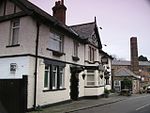Once Brewed
Use British English from August 2019Villages in Northumberland

Once Brewed (also known as Twice Brewed or Once Brewed/Twice Brewed) is a village in Northumberland, England. It lies on the Military Road (Northumberland) B6318. A motorist arriving over the B6138 from the east will see the place name shield "Once Brewed", while those coming from the west will read "Twice Brewed". Once Brewed lies just south of Hadrian's Wall, which runs along the top of the Whin Sill ridge above the village to the north. The Roman fort of Vindolanda is a couple of miles away to the south-east. The Roman earthwork known as the Vallum runs right past Once Brewed, adjoining and also overlain by the Military Road.
Excerpt from the Wikipedia article Once Brewed (License: CC BY-SA 3.0, Authors, Images).Once Brewed
Military Way,
Geographical coordinates (GPS) Address Nearby Places Show on map
Geographical coordinates (GPS)
| Latitude | Longitude |
|---|---|
| N 55.001 ° | E -2.385 ° |
Address
Military Way
Military Way
NE47 7AH
England, United Kingdom
Open on Google Maps









